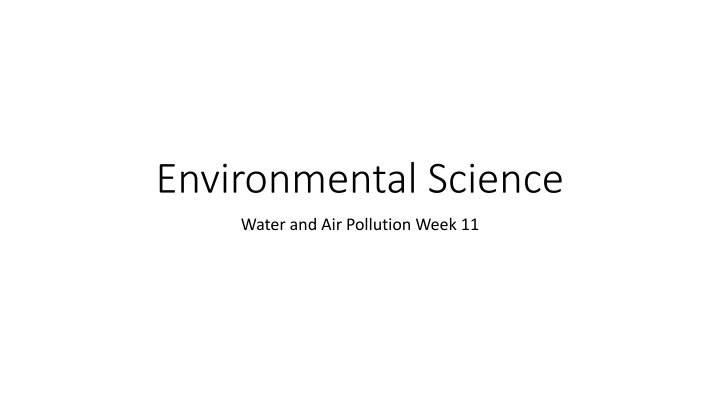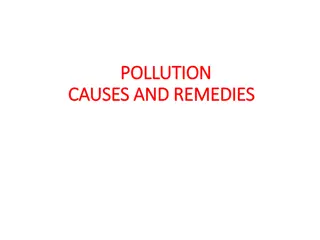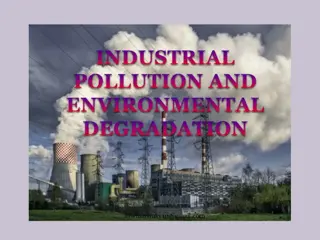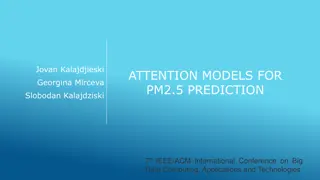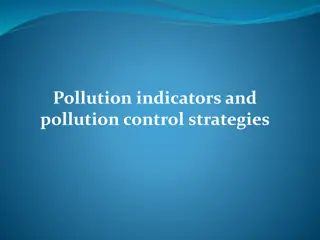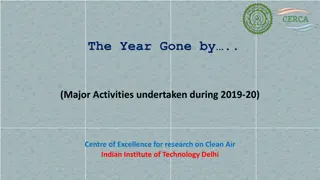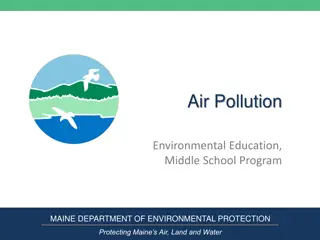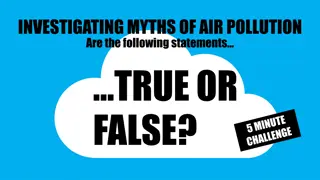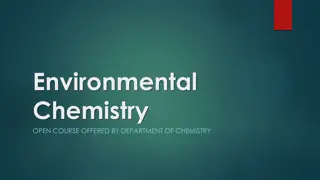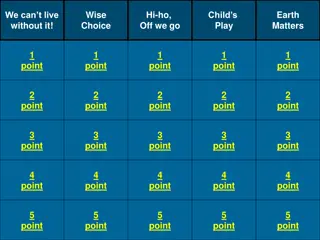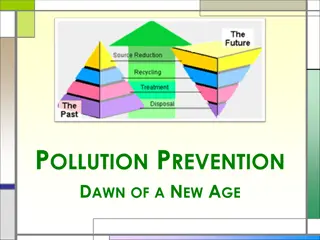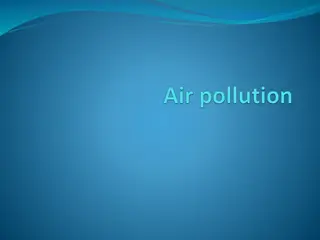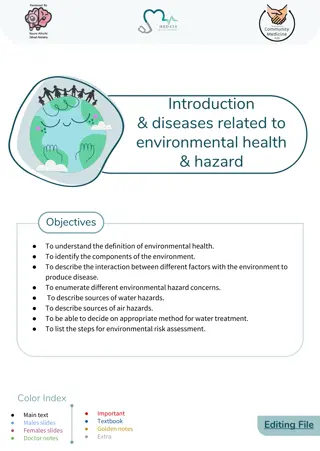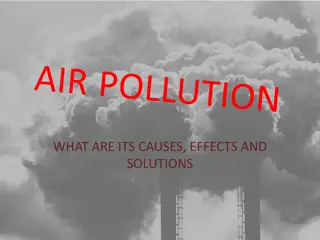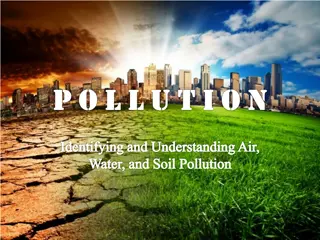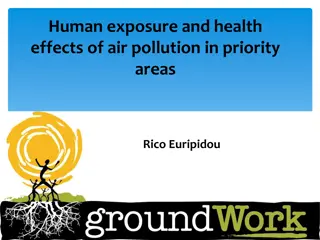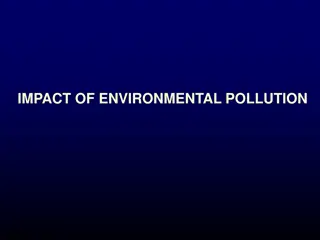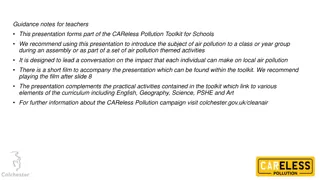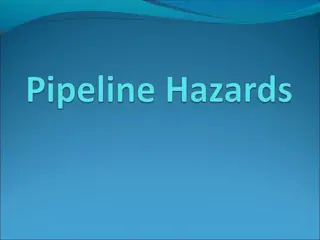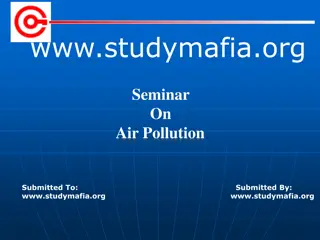Causes of Air Pollution and Health Hazards
Primary air pollutants, sources in urban areas, and the formation of smog. Learn about the impact of pollutants on health and the filtration of contaminants in water. Understand the significance of porosity and permeability of soils in filtering highly toxic substances like perchlorates and metals.
Download Presentation

Please find below an Image/Link to download the presentation.
The content on the website is provided AS IS for your information and personal use only. It may not be sold, licensed, or shared on other websites without obtaining consent from the author.If you encounter any issues during the download, it is possible that the publisher has removed the file from their server.
You are allowed to download the files provided on this website for personal or commercial use, subject to the condition that they are used lawfully. All files are the property of their respective owners.
The content on the website is provided AS IS for your information and personal use only. It may not be sold, licensed, or shared on other websites without obtaining consent from the author.
E N D
Presentation Transcript
Environmental Science Water and Air Pollution Week 11
10/26 What Causes Air Pollution? CH12.1 Obj. TSW understand the causes of air pollution and the hazards to health. P. 16 NB 1. Name 5 primary air pollutants and give sources for each. 2. Name two major sources of air pollution in urban areas. 3. Describe the way in which smog forms.
Primary Air Pollutants Carbon Monoxide (CO) Nitrogen Oxides (NOx) Sulfur Dioxide (SO2) Volatile Organic Compounds (VOC s) Particulate Matter (PM) Mark J. Perry @Mark_J_Perry March 23, 2010 6:42 am | AEIdeas
Mark J. Perry @Mark_J_Perry March 23, 2010 6:42 am | AEIdeas
Lab Ground Water Filters p. 300 301 ESBK Contaminant page 17 NB Before Filtration Description After Filtration Description Water (Control) Water Clean, no smell Water, dirty Water (Control) Water, clear, clean, no smell Water mixed, dirty, brown, smells like dirt Brown, feels like muddy water Sodium Chloride (Salt) 1 TSP It is opaque, (white) smells salty, feels like denser water Sodium Bicarbonate (Baking Soda) 1 TSP Food Coloring (Blue) 5 drops Brown river, sewage water Dirty green, smells like dirty sand Light green, yellow Liquid Blue Food Coloring (Green) 5 drops Dark Green Water Mountain Dew color, dirty green Maple Syrup 1 TSP Thick deep amber strong scent Thin yellow amber, barely smells Vegetable Oil 1 TSP Clean water bubbles, from oil No signs of oil, soil filtered oil
Lab Report Porosity and Permeability of Soils impact filtration of pollutants. How will you test the result of filtering your pollutant? What procedure will you use to test the filtration of your pollutant? What does the porosity and permeability of the soil mean for highly toxic substances like perchlorates? Or metals? How much water was filtered out the first time? The second time, how much water was there and how was it different?
10/27 Air Pollution CH 12.1 & 12.2 Obj. TSW learn how primary pollutants contribute to secondary pollutants. P. 18 NB 1. Describe a temperature inversion and list what cities have them. 2. What are the short term and long term effects of air pollution on health. 3. Describe some indoor air pollutants.
Temperature Inversion
Create your questions for your Quiz CH 11 Level 1: only 1 point, 1 word, short phrase answer Level 2: 2 points, 1 2 complete sentences for an answer Level 3: 3 points, Includes a definition, and example and an explanation or significance
Point Source and Non-Point Source Pollution 19NB Write an AXES Paragraph about our topic. Define each. Give an Example of how they are similar and how they are different. Explain what happens. Show why is it important to us. Maybe include or reference some of the Laws or Acts Page 293. ESBK
Taboo Ground Water Watershed Potable Dam Water pollution Clean Water Act
Taboo Aquifer Porosity Permeability Desalinization Point source Pollution
10/28 Air, Noise & Light Pollution CH 12.2 Obj. TSW learn about pollution caused by noise and light. P. 20 NB 1. Describe Sick Building Syndrome. 2. Noise Pollution can cause harm, What is the threshold for pain? What are some activities that cause this? 3. Light pollution is an environmental concern. Why?
Agenda 10/29 WU Go over quiz Finish WS Discuss article Watch How the Universe was made cars Students will write 3 open ended questions.
WS P. 21 NB 1. IV paper clips/ Mass DV Distance it would fly Control Paper airplane w/out paper clips Constants- Paper, paperclips 2. IV Calculators DV speed working with math problems Control students w/o calculators Constants- math problems, same calculators 3. IV Ages of students DV Puzzle assembly time Control - ? Constants Puzzle 4. IV Amount of Coffee Grounds DV the taste of the coffee Control The minimum amount of coffee used. Constants- type of water, same percolator, electrical sources, coffee
10/29 Acid Precipitation CH 12.3 Obj. TSW understand the causes and effects of acid precipitation. P. 22 NB 1. Explain the cause of Acid Precipitation. 2. Draw the Acid Precipitation cycle in figure 3.2. 3. Explain how acid precipitation affects plants soils and aquatic systems.
10/30 Acid Precipitation Conflicts & Cooperation CH12.3 Obj. TSW learn how air pollutants affect humans and how countries have to act together to decrease the harmful affects on the environment. P. 24 NB 1. How does Acid precipitation affect humans? 2. How can pollutants from the US produce acid precipitation in Canada? 3. What is the result of the Canada- U.S. Air Quality Agreement I 1991?
How the Universe Built your car p. 25 NB Create 3 open ended questions, you can not find the answer to in your book
Ground Water Filter Lab Introduction: Discuss Ground Water and Aquifers.
